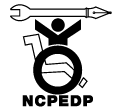National Centre for Promotion of Employment for Disabled People
![]() Disabled People Call for Political Recognition and Action
Disabled People Call for Political Recognition and Action
Context
The project has completed a 23 years journey. And yet, the most critical policy step remains unaccomplished – quality implementation of the policy on TV channels.
Same Language Subtitling (SLS) is simply the idea of subtitling the lyrics of existing film songs (or music videos) on TV, in the ‘same’ language that they are sung in. SLS on songs cause automatic and inescapable reading practice and overcomes the motivational barrier to reading practice amongst weak readers. It is Karaoke on Bollywood for mass reading.
About SLS project
Its aim was to examine whether the subtitling of mainstream TV content could help people, especially those who were hard to reach through traditional literacy programmes, to improve their reading and writing skills.
In 1999, SLS was officially put into practice as a literacy intervention programme by the Indian Institute of Management, Ahmedabad (IIMA), and the not-for-profit organization Planet Read.
- SLS has the proven power to transform much of TV and OTT content consumption into routine reading practice that is inescapable, subconscious, sustainable, scalable, and extremely cost-effective.
- The ‘Accessibility Standards’ of the Ministry of Information and Broadcasting (MIB), framed in September 2019 under the Rights of Persons with Disabilities Act, 2016, require 50% of all entertainment content on TV to carry captions in the same language, or SLS, by 2025.
The main approach of SLS is quite simple: to subtitle audio visual content in the language of the audio track so the on-screen text and audio match perfectly. While watching TV, viewers can match the words on screen to the sounds they are hearing simultaneously.
Funder
Partners
Significance and potential of the project
- When SLS is implemented on TV in all Indian languages, as broadcast policy now stipulates, it will automatically give daily reading practice to an estimated 600 million weak readers who currently cannot read and understand simple text, like a newspaper.
- Within three to five years of regular exposure to SLS on entertainment content already watched, many of them will become functional and some even fluent readers.
Background
COVID 19 pandemic situation
Way ahead
This is in addition to having massive national impact in two other domains, that of media access among Deaf and Hard of Hearing (DHH) people and of language learning.
Problem
Solution
Eye-tracking studies have demonstrated that SLS gives automatic reading practice to weak-reading viewers. The evidence from pilot studies of SLS implementation on TV in eight Indian languages (Hindi, Bengali, Gujarati, Marathi, Telugu, Tamil, Kannada & Panjabi) is strong. Regular SLS exposure results in steadily improving reading skills among all viewers: children in and out of school, youth, and adults. A billion viewers in India watch four hours of TV every day, and will do so for life. Reading practice from SLS is incredibly cost-effective and scalable.
Globally, SLS for mass reading literacy was first conceived at IIM Ahmedabad in 1996. In 2019, after 2+ decades of evidence-based-policy-making, SLS became a part of the Ministry of Information and Broadcasting’s (MIB) Accessibility Standards, under the Rights of Persons with Disabilities Act, 2016.[1] Half the entertainment content on TV, in every language, state, and channel, is required to carry SLS by 2025. The international acceptance of SLS is growing.
- Scaling up SLS for a 3-5 year project period on state and private TV channels.
- Agreeing on a matching funding mechanism for the project period while putting in place a long-term sustainability strategy.
- Conducting an independent impact study.

